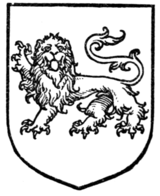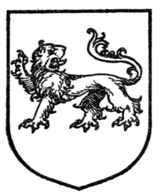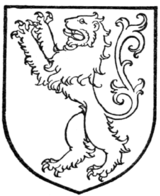ground. The two forepaws are usually placed together (Fig. 300). Whilst but seldom met with as a charge upon a shield, the lion statant is by no means rare as a crest.
Lion statant tail extended.—This term is a curious and, seemingly, a purposeless refinement, resulting from the perpetuation in certain cases of one particular method of depicting the crest—originally when a crest a lion was always so drawn—but it cannot be overlooked, because in the crests of both Talbot, Earl of Shrewsbury, and Percy, Duke of Northumberland, the crest is now stereotyped as a lion in this form (Fig. 301) upon a chapeau.
Lion statant guardant (Fig. 302).—This (crowned) is of course the Royal crest of England, and examples of it will be found in the arms of the Sovereign and other descendants, legitimate and illegitimate, of Sovereigns of this country. An exceptionally fine rendering of it occurs in the Windsor Castle Bookplates executed by Mr. G. W. Eve.
Lion salient.—This, which is a very rare position for a lion, represents it in the act of springing, the two hind legs being on the ground, the others in the air (Fig. 303).









